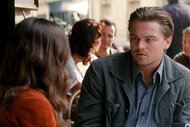Create a free profile to get unlimited access to exclusive videos, sweepstakes, and more!
'Minority Report' started with a 2054 'think tank summit' - watch it now on Peacock!
Steven Spielberg called on real-life scientists to craft a sci-fi future that’s starting to look eerily familiar.

Part of the genius of Steven Spielberg’s Minority Report is the way the movie hides its dystopia beneath the comforting skin of the familiar. Now streaming on Peacock, the 2002 sci-fi crime thriller starring Tom Cruise envisioned a near-future world not so different from our own, a place where technology might be capable of predicting the next murder…but also wants to nudge you toward your next sweater purchase.
Placing Washington, D.C. “Precrime” police chief John Anderton (Cruise) at the center of a murder case that bucks the advanced program’s always-reliable predictive powers, Minority Report was inspired by a 1950s novella by sci-fi legend Philip K. Dick. But Dick never painted in the details surrounding his original story’s vaguely futuristic setting, leaving Spielberg to envision what the movie’s version of life in a mid-21st Century vision of D.C. might look like.
RELATED: Watch: Everything you didn’t know about ‘Minority Report,’ Steven Spielberg’s neo-noir thriller
For that, Spielberg needed some expert help — so before writers Jon Cohen and Scott Frank dove fully into the film’s screenplay, he assembled a team of 15 or so outside-the-box thinkers. For three days at a Santa Monica, Calif. hotel, the group bandied about its best informed guesses of what the Washington of 2054 might look like — all on Spielberg’s dime, of course — and ended up with a number of suggestions that lent the world of Minority Report a distinctive flavor that set the film apart from previous sci-fi movie takes on futuristic settings (think Blade Runner — another sci-fi film also inspired by a Dick story).
The big reference document that came out of what’s since been unofficially dubbed as the movie’s “think tank summit” is the “2054 bible,” a handy Minority Report lore guide compiled by production designer Alex McDowell that “laid out in about 80 pages or so the entire world that we were going to build,” as fellow summit mind John Underkoffler would later tell Salon.
“It covered everything,” said Underkoffler, “from architectural overviews, the trends that had led to more vertical buildings and cities, the urban areas pulling in the skirts, so to speak, and rising into the air to allow green to return to surrounding lands (that sort of ecological imperative), the political tenor of the times, the individual economics of different social strata that led to certain architectural forms, right on down to the gadgets — the nonlethal weapons, the hover packs, the little spider robots that run around and identify you.”
One of the biggest takeaways from the meeting was to envision a future where the film’s privacy-eroding techno-creep at least offered people enough quality-of-life conveniences to make its dystopian implications arguably seem worth the tradeoff. As summit guest and auto designer Harald Belker told Salon, Blade Runner had “painted a very dark view of the future. And many, many sci-fi films after that kind of reflected what Blade Runner had started. So, there was a conscious effort to go the other way, to make it a positive, bright future where we solve a lot of problems and make life more pleasant.”
The movie, of course, puts Cruise’s character through the dystopian wringer and ultimately chooses sides: By the end, the ethically sketchy Precrime program is disbanded, its human guinea pigs freed from indefinite captivity, and its corrupt creator disgraced. But the Precrime program and its quasi-paranormal reliance on a trio of sensory-deprived clairvoyant fortune tellers stands out as perhaps its most far-fetched sci-fi concept. After all, tons of smaller technological stuff that Minority Report predicted back in 2002 has since come to pass — at least in some form or fashion.
RELATED: 'Jurassic Park,' 'E.T.,' and more: Steven Spielberg's best sci-fi films, ranked
“We were doing these glove technologies that could be combined with displays,” VR computer scientists Jaron Lanier would later tell Wired of the motion-controlled computer interface — largely created for the film by Underkoffler — that Cruise famously swipes like a music conductor in his D.C. Precrime office. Though the details are appropriately movie-dramatic, the tech itself anticipated today’s still-emerging gesture-based interfaces by decades: “That was totally commonplace during that time as a demo thing,” said Lanier — “not as a consumer product.”
Spielberg himself wanted his turn-of-the-century movie to take realistic steps toward a real-world future he believed was inevitable. Speaking with the late Roger Ebert upon the movie’s 2002 release, the director confessed to hoping that “all” of Minority Report’s futuristic “toys” would one day be commonplace stitches in society’s functional fabric. But, he cautioned, people might come to regret swapping their personal privacy for the conveniences that come from all the eye-scanning, browser-tracking, currency-stalking surveillance going on behind the scenes.
“The Internet is watching us now,” he told Ebert. “If they want to. they can see what sites you visit. In the future, television will be watching us, and customizing itself to what it knows about us. The thrilling thing is, that will make us feel we're part of the medium. The scary thing is, we'll lose our right to privacy.”
How much of our computer-powered fate did Minority Report really predict? Catch Spielberg’s classic sci-fi thriller streaming now at Peacock.


























